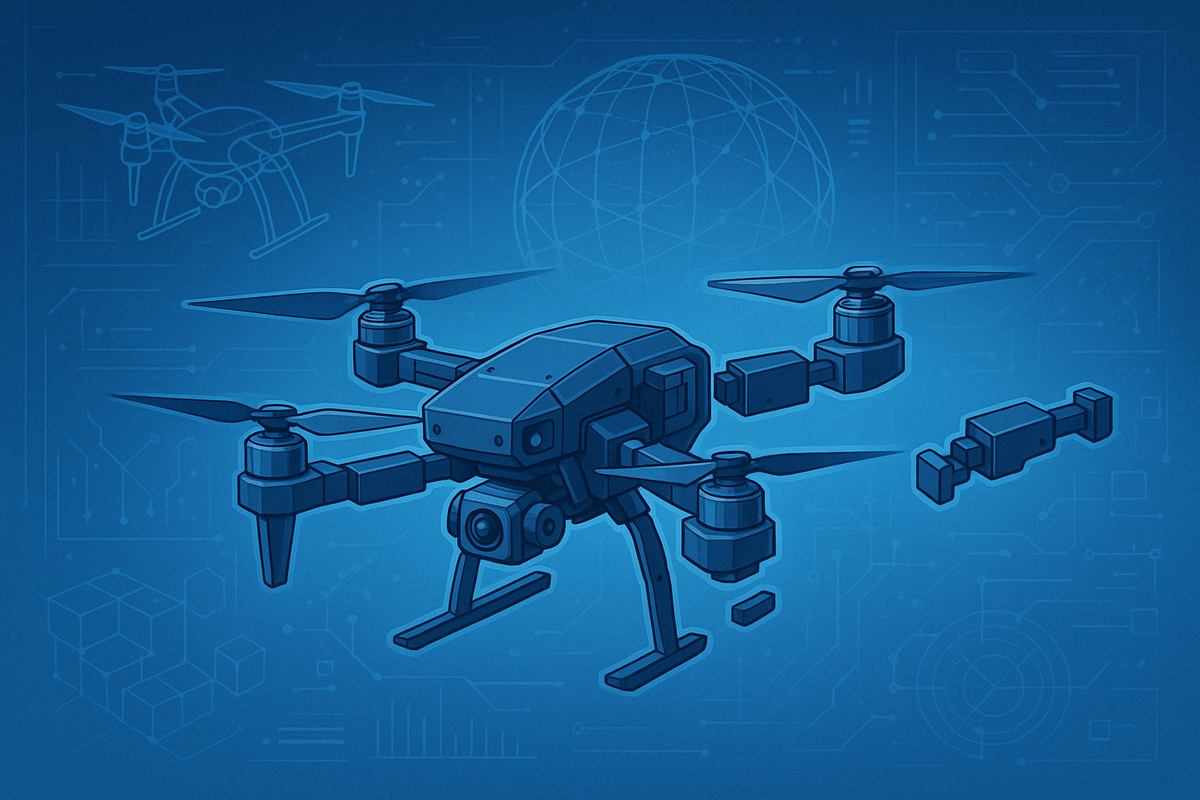SkyTech Orion Global (CTGL): How LEGO-Style Drones Are Redefining Innovation

For thousands of years, war has been humanity’s most brutal teacher, and its most powerful catalyst for progress. From the bronze forges of ancient Egypt to the nuclear laboratories of World War II, conflict has repeatedly forced civilizations to invent faster, build smarter, and adapt or perish. Every major leap in military capability, from metallurgy and navigation to radar and computing, has eventually rewritten the fabric of civilian life.
Today, that historical pattern is repeating in real time across the skies of Ukraine and the Middle East, where low-cost unmanned vehicles have transformed the modern battlefield. Yet the deeper story is about invention. What began as a wartime improvisation has evolved into the foundation of a new industrial age: modular, reconfigurable, and intelligent machines that blur the line between military hardware and civilian robotics.
One maverick of this transformation is SkyTech Orion Global (OTCQB: CTGL)—a company whose Click & Fly™ modular drone platform could become the defining dual-use technology of the next decade.
A Familiar Story of Necessity and Invention
History makes clear that necessity compresses innovation timelines. The Egyptians learned to smelt bronze to survive invasion. The Greeks built triremes to control trade routes. Rome engineered concrete and highways for conquest, then left behind the world’s first logistics empire. Gunpowder ended feudalism; radar and jet engines ushered in the modern world.
Each leap followed the same curve: technology born for war later became indispensable in peace. The same process that once turned catapults into cranes and battlefield surgery into modern medicine is now turning battlefield drones into the scaffolding of a new robotic economy.
The Drone Wars That Changed Everything
When Russia invaded Ukraine in 2022, it triggered not just the largest ground war in Europe since 1945, but also the first conflict dominated by small, semi-autonomous aircraft. By 2025, drones accounted for roughly 70 percent of battlefield losses on both sides. Ukrainian forces were producing over 200,000 First-Person-View drones each month, each costing less than $1,000 and capable of destroying multimillion-dollar assets.
The economic asymmetry was staggering: a $600 machine eliminating a $10 million tank. Behind that math lies a revolution in manufacturing philosophy.
Israel’s experience paralleled Ukraine’s. In Gaza and along the northern front, the Israel Defense Forces integrated small drones into every platoon. Commercial DJI platforms were retrofitted to carry munitions or deliver real-time surveillance. At the same time, Israel accelerated the use of autonomous “ghost” units and electromagnetic counter-drone technologies, effectively creating a full digital ecosystem of airborne robotics.
What these conflicts demonstrated is that drones are consumable, software-defined instruments of continuous adaptation. The next logical step is automation: drones that build, repair, and even replicate themselves.
SkyTech Orion Global: The Click & Fly™ Breakthrough
Into this environment steps SkyTech Orion Global, whose patented Click & Fly™ system represents the first commercially viable embodiment of this modular ideal. Announced in late 2025, SkyTech’s Replicator platform allows an operator to assemble or reconfigure a drone within seconds, entirely without tools. Motors, sensors, and payloads snap together through sealed interlocking joints that carry both power and data internally—no exposed wires, no fragile connectors, and no weather limitations.
This single innovation solves the Achilles’ heel of modular systems: reliability under stress. SkyTech’s design can fly in rain, snow, desert dust, or maritime spray, and represent the first truly all-weather modular platform. Backed by multi-million-dollar Israeli grants and a partnership with Stratasys for distributed 3D printing, the company has established dual manufacturing hubs in the U.S. and Israel, both fully NDAA-compliant. Production is scheduled to scale in 2026.
In practice, the Replicator functions as a universal chassis. One core “brain” connects to a growing library of “smart arms” and payloads—optical, thermal, kinetic, or logistical. The result is a single system that can transform from reconnaissance to strike to cargo delivery in moments. SkyTech describes it as one brain, infinite drones, and the phrase isn’t marketing hyperbole; it captures a paradigm shift in design thinking.
From Edge Manufacturing to Edge Autonomy
The Replicator’s modularity gains exponential power when combined with edge manufacturing, which are deployable 3D printing systems capable of producing airframes and components directly in the field. Ukrainian units have already demonstrated containerized factories printing hundreds of drones per week. SkyTech’s partnership network aims to formalize that model, turning front-line logistics into flexible micro-manufacturing.
This convergence of design modularity and distributed fabrication marks the birth of industrial decentralization: the ability to create complex machines anywhere, on demand, without centralized supply chains. In peacetime, that capability translates into faster product cycles, lower transportation emissions, and greater resilience for industries from construction to energy infrastructure.
Beyond the Battlefield: Civilian and Commercial Horizons
The same qualities that make modular drones invaluable to soldiers, such as speed, adaptability, and weather resistance make them transformative for civilian markets. In emergency response, all-weather drones can fly through storms to locate survivors or deliver medical supplies. In agriculture, they can switch from crop-spraying to multispectral imaging in minutes. Utility companies can inspect power lines immediately after hurricanes instead of waiting for clear skies.
By opening its ecosystem to third-party developers, SkyTech Orion Global can replicate the network effects that once powered the smartphone era. Each new module, whether designed for defense, logistics, cinematography, or surveying, expands the platform’s value. The company’s long-term vision echoes the early days of the personal-computer industry: standardize the connection system, invite innovation from everywhere, and become the infrastructure layer for a trillion-dollar robotics market.
The Rise of Agentic AI
While modular hardware provides adaptability, the intelligence that controls it is evolving just as quickly. Ukraine and Israel have both deployed autonomous swarms governed by artificial intelligence capable of coordinating complex missions with minimal human input. These systems can analyze targets, allocate roles, and adjust tactics in real time—a glimpse of what experts now call agentic AI.
Agentic AI extends beyond drones; it represents machines that act with purpose, adapting to feedback without direct oversight. When merged with SkyTech’s hardware, this intelligence could enable fleets of drones that repair infrastructure, map terrain, or secure perimeters autonomously. What once required human pilots becomes a network of robotic agents responding dynamically to their environment.
Economic and Strategic Implications
The dual-use modular-drone and robotics sectors are projected to exceed $400–$500 billion in annual global value by 2033. Within that ecosystem, SkyTech Orion Global’s intellectual property, its weatherproof internal-wiring architecture and patented interlocking mechanism, positions the firm as both first mover and gatekeeper. Analysts estimate that if the company’s Click & Fly™ system becomes the modular standard, CTGL’s valuation could reach $50–$80 billion by the early 2030s.
For the U.S. military, this technology promises a strategic leap. Instead of relying on rigid procurement cycles, defense forces could license open modular frameworks, printing or assembling mission-specific drones at forward bases. The Pentagon’s shift toward a Modular Open Systems Approach (MOSA) aligns perfectly with SkyTech’s design philosophy.
For investors, the implication is equally profound. The world is entering a phase where dual-use innovation, technologies equally viable in combat and commerce, commands the highest multiples. SkyTech’s structure, spanning defense, advanced manufacturing, and industrial automation, gives it exposure to every major frontier of that movement.
The New Arc of Innovation
Every war leaves behind a peace shaped by its inventions. The wheel and the plow were once chariot technology; the internet was born from nuclear-age fear. Now, from the debris of modern drone warfare, a new class of intelligent machines is emerging—adaptive, modular, and self-directed.
SkyTech Orion Global embodies that legacy. Its Replicator platform transforms the lessons of Ukraine and Israel into the building blocks of a new industrial future, one where the same system that saves soldiers’ lives can one day rebuild bridges, fight wildfires, or deliver medicine in the rain.
War accelerates innovation. Peace is where the dividends are collected. And in this cycle, SkyTech Orion Global appears positioned to collect them first.
Disclosure: The author currently owns shares of SkyTech Orion Global (CTGL) and may buy or sell shares at any time without notice. The views expressed are solely those of the author and are provided for informational purposes only. This article does not constitute investment advice or a recommendation to buy or sell any security. Investors should perform their own due diligence and consult with a qualified financial advisor before making any investment decisions.





